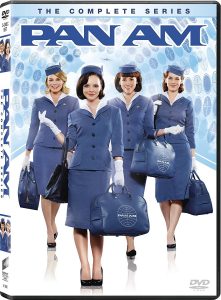There’s a snort-out-loud scene in the “Family Guy” parody of “Return of the Jedi” where C-3PO explains why he’s wearing a suit and tie aboard the Millennium Falcon: “Some people still think of flying as an occasion.”
In “Pan Am” (9 p.m. Central Sundays on ABC), the latest network period drama that will no doubt develop a passionate fanbase but be prematurely canceled, flying truly is an occasion. Since I wasn’t around in the 1960s, I don’t know what’s historically accurate and what isn’t, but here’s what we get in the first episode:
- The stewardesses (they weren’t yet called flight attendants) on the international flight speak multiple languages (one of them is, in fact, French), and abide by a strict dress code of girdle, stockings, a pressed blue suit and a funny little hat. More than just the person that bumps your elbow with the drink cart, they are minor celebrities — in moments both subtle and blunt (check out the Life magazine cover again, in case you missed it the first nine times), the pilot episode tells us that this is the new breed of woman, not content to land a husband and keep a tidy house ’50s-style.
- The planes are as spacious and luxurious as they always are in fiction, but never seem to be in real life. The plane we see in the pilot actually has one of those half-circle lounge couches like you’d see in a club.
- Flying (even the airport part of it) is something to be enjoyed, rather than a series of annoyances, as it is today.
- People behave just like they do today, they just don’t have the technology yet. The cameras they use for their travel pictures are hilariously gigantic. And when one stewardess, Maggie (Christina Ricci) wants to go into a different room to talk on the phone, she has to stretch the cord as far as it will go; cellphones weren’t even a twinkle in these characters’ eyes.
- Adding to the rose-colored mystique of “Pan Am,” no one smokes on the plane. In reality, they did. I don’t mind at all that they left out this detail; it would’ve ruined the romance of it all.
Like the much-missed “American Dreams” and “Swingtown,” “Pan Am” is lush with period details. Granted, the Life magazines and vintage brochures look like they are historical collectibles rather than freshly printed items; perhaps the set dressers should’ve made re-creations rather than using the actual items. But that’s a small quibble; in general, “Pan Am” takes you back to the 1960s. There’s a shot of a rainy London street that somehow looks like London in the 1960s rather than London today; I don’t know exactly what tricks they used, but it worked.
That just leaves this question: “Beyond the undeniably cool museum tour, why should I watch ‘Pan Am’ week to week?” “American Dreams,” with its ’60s family life, and “Swingtown,” with its ’70s sexual freedom, had specific hooks.
Certainly, the nostalgic feeling carries “Pan Am” through its first episode. When Maggie dashes out of her Greenwich Village apartment, her beat-poet roommate who is hunched over his typewriter argues that he doesn’t have to see the world to change it. Maggie disagrees, as she holds her stewardess job for the express purpose of Seeing The World (the big-eyed Ricci is perfectly cast in this role).

But when the arcs get more specific, they get creaky: Colette (Karine Vanasse) is involved with a married man. Kate (Kelli Garner) is recruited to be an international CIA messenger. She isn’t sure if she wants her younger sis, Laura (Margot Robbie), working on the same crew as her; she likes the idea of having family at home to come back to. As for Maggie, well, she has trouble following the dress code; it’s implied that — gasp! — she didn’t wear her girdle on one flight. Also, there’s the mysterious fifth stewardess, Bridget (Annabelle Wallis), who was Kate’s precursor with the CIA and is wandering the world somewhere.
Also, as we see in flashbacks, there’s a love story between pilot Dean (Mike Vogel) and Bridget. He’s desperately searching for this woman who doesn’t want to be found.
In terms of narrative, “Pan Am” seems to be desperately searching for a purpose. Sure, it looks amazing and has a definite sense of time and place. But why are we following these specific characters? I expect we’ll get better answers in the coming weeks; if not, I might have to disembark early.
What were your thoughts on the first episode? Do the character arcs hook you or seem a little dull? Will you be back for episode two?

